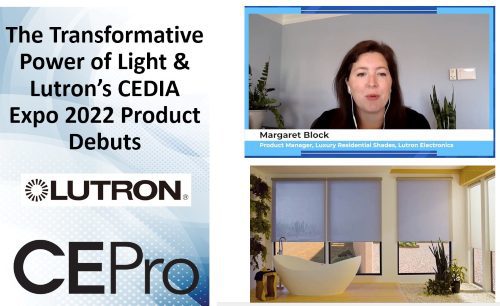Light is transformative. It can change the look and feel of any space. When designing a home, architects are always looking for ways to dissolve the boundary between the interior and the exterior — creating a feeling of comfort and security, and a connection with the outdoors depending on what the moment calls for — and automated shades and fully tunable lighting systems are inextricably part of the architecture.
Lutron offers whisper-quiet, automated shades that act as a natural extension to the light control system, balancing access to sunlight with sanctuary from it. Automated shades make it easier and more convenient for homeowners to take advantage of available natural light and dramatic views, but when they are integrated into a home control system, the results can be is magical. One example is Lutron’s Natural Light Optimization for Triathlon Wood Blinds, which enables more than just blinds that tilt at the press of a button — they can be set up to know the direction of the window and the position of the sun throughout the day, beyond sunrise and sunset. This makes it simple to optimize the amount of daylight in a space, while allowing integrators and homeowners to customize the behavior, for example, to prioritize privacy or to allow more light into a family room.
“Motorized shades are such an exciting category right now,” says Margaret Block, product manager, luxury residential shades, Lutron Electronics. “There’s such a design element to it, and I think everyone would agree that the way that daylight comes into a room absolutely changes the look and feel of that space.”
She continues, “Integrators that are really effective at working with interior designers do a couple of key things. First, they have quick access to the materials and resources that interior architects and designers need. So those could be specification resources, being able to quickly find materials and sampling right to give to those designers when they need it. Second, they also know how to really simply explain how the system works in really simple language, so that a designer understands what they’re offering is different than maybe a traditional approach.
“Another great thing that I’ve seen is integrators are really able to articulate the functional benefits of a fabric. So, being able to say, ‘This 3% fabric versus a 10% fabric is going to do this to the light coming into this space. Or, discussing the differences between a light-colored fabric versus a dark-colored fabric for optimizing views.
“Lastly, when integrators are working with interior designers, it’s really just about empowering them to execute on their clients vision. It’s not about necessarily specifying the solution or specifying the fabric, but helping them understand what options are available so that they can curate that,” she explains.
Block reviewed with CE Pro the product debuts from the company at CEDIA Expo 2022, including its new Palladiom Wirefree shades, Triathlon Wood Blinds with intelligent sensing ability, and new Architectural Honeycomb shades.
Lutron acts as a partner in this endeavor, providing best-in-class shading systems for over 20 years and simple software solutions, ensuring that daylight control is more than intuitive — it’s second nature. Visit luxury.lutron.com to learn more about beautiful light, intelligent shades and harmonious controls.







